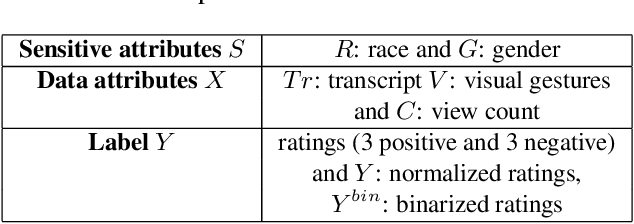Md. Iftekhar Tanveer
Persistence Homology of TEDtalk: Do Sentence Embeddings Have a Topological Shape?
Mar 25, 2021


Abstract:\emph{Topological data analysis} (TDA) has recently emerged as a new technique to extract meaningful discriminitve features from high dimensional data. In this paper, we investigate the possibility of applying TDA to improve the classification accuracy of public speaking rating. We calculated \emph{persistence image vectors} for the sentence embeddings of TEDtalk data and feed this vectors as additional inputs to our machine learning models. We have found a negative result that this topological information does not improve the model accuracy significantly. In some cases, it makes the accuracy slightly worse than the original one. From our results, we could not conclude that the topological shapes of the sentence embeddings can help us train a better model for public speaking rating.
Fairness in Rating Prediction by Awareness of Verbal and Gesture Quality of Public Speeches
Dec 16, 2020



Abstract:The role of verbal and non-verbal cues towards great public speaking has been a topic of exploration for many decades. We identify a commonality across present theories, the element of "variety or heterogeneity" in channels or modes of communication (e.g. resorting to stories, scientific facts, emotional connections, facial expressions etc.) which is essential for effectively communicating information. We use this observation to formalize a novel HEterogeneity Metric, HEM, that quantifies the quality of a talk both in the verbal and non-verbal domain (transcript and facial gestures). We use TED talks as an input repository of public speeches because it consists of speakers from a diverse community besides having a wide outreach. We show that there is an interesting relationship between HEM and the ratings of TED talks given to speakers by viewers. It emphasizes that HEM inherently and successfully represents the quality of a talk based on "variety or heterogeneity". Further, we also discover that HEM successfully captures the prevalent bias in ratings with respect to race and gender, that we call sensitive attributes (because prediction based on these might result in unfair outcome). We incorporate the HEM metric into the loss function of a neural network with the goal to reduce unfairness in rating predictions with respect to race and gender. Our results show that the modified loss function improves fairness in prediction without considerably affecting prediction accuracy of the neural network. Our work ties together a novel metric for public speeches in both verbal and non-verbal domain with the computational power of a neural network to design a fair prediction system for speakers.
FairyTED: A Fair Rating Predictor for TED Talk Data
Nov 25, 2019



Abstract:With the recent trend of applying machine learning in every aspect of human life, it is important to incorporate fairness into the core of the predictive algorithms. We address the problem of predicting the quality of public speeches while being fair with respect to sensitive attributes of the speakers, e.g. gender and race. We use the TED talks as an input repository of public speeches because it consists of speakers from a diverse community and has a wide outreach. Utilizing the theories of Causal Models, Counterfactual Fairness and state-of-the-art neural language models, we propose a mathematical framework for fair prediction of the public speaking quality. We employ grounded assumptions to construct a causal model capturing how different attributes affect public speaking quality. This causal model contributes in generating counterfactual data to train a fair predictive model. Our framework is general enough to utilize any assumption within the causal model. Experimental results show that while prediction accuracy is comparable to recent work on this dataset, our predictions are counterfactually fair with respect to a novel metric when compared to true data labels. The FairyTED setup not only allows organizers to make informed and diverse selection of speakers from the unobserved counterfactual possibilities but it also ensures that viewers and new users are not influenced by unfair and unbalanced ratings from arbitrary visitors to the www.ted.com website when deciding to view a talk.
 Add to Chrome
Add to Chrome Add to Firefox
Add to Firefox Add to Edge
Add to Edge